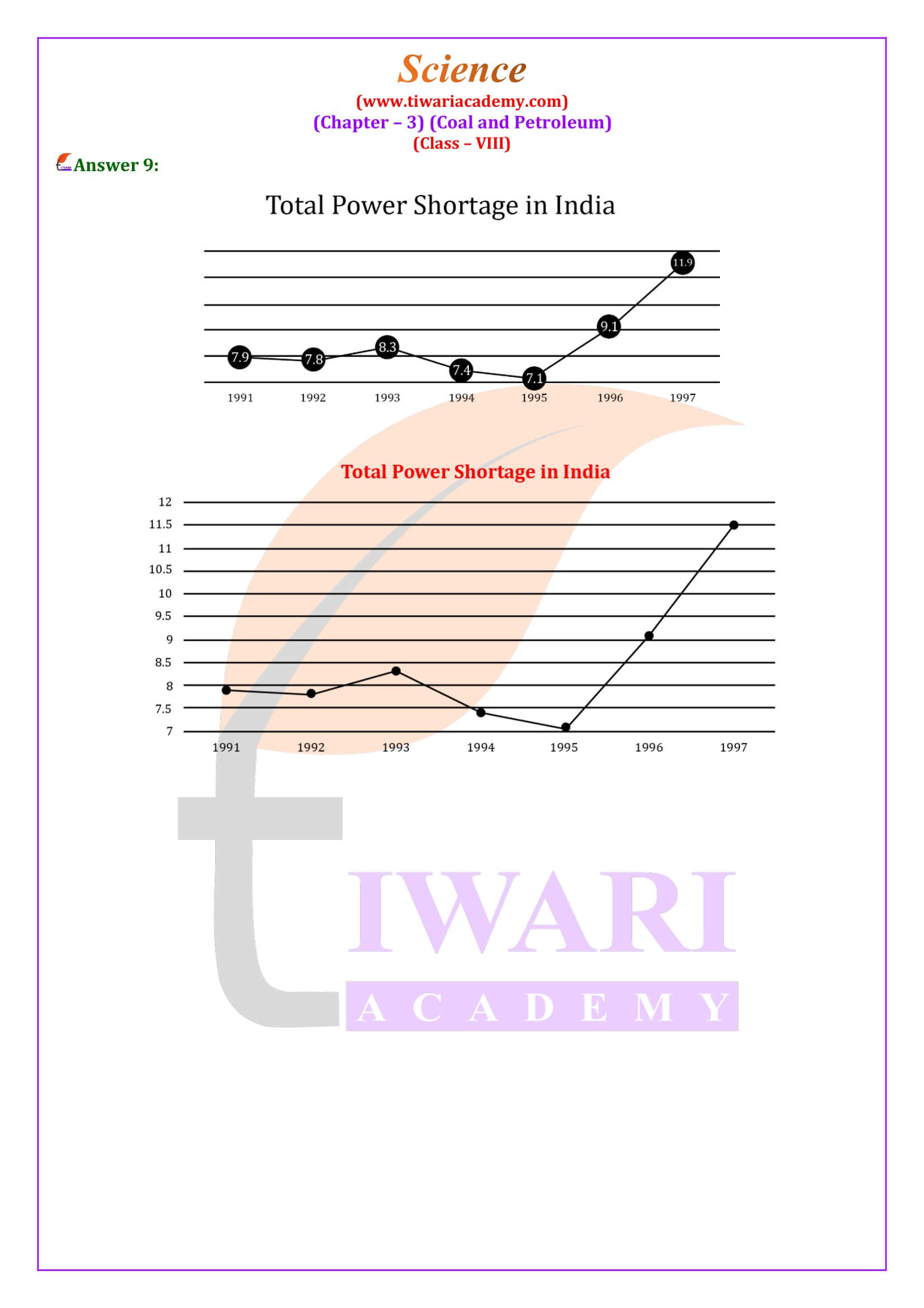Question Wise Class 8 Science Chapter 3 Solutions
Class 8 Science Chapter 3 NCERT Answers
Class 8 Science Chapter 3 in Hindi Medium
Class 8 Science Chapter 3 Extra Questions
Class 8 Science Chapter 3 MCQ
Class 8 Science NCERT Book Download
Class 8 Science Chapter 3 Exemplar Book
Class 8 Science Chapter 3 Exemplar Answers
Class 8 Science NCERT Solutions
Class 8 all Subjects NCERT Solutions
NCERT Solutions for Class 8 Science Chapter 3 Coal and Petroleum in English and Hindi Medium whether you Study online or go for download in PDF format. The contents are updated for 2025-26 based on latest NCERT Textbooks for new session. NCERT Textbook and its Solutions of other subjects are also available. Question answers are modified as per new NCERT books issued for session 2025-26.
| Class: 8 | Science |
| Chapter 3: | Coal and Petroleum |
| Content: | NCERT Solutions, MCQ and Extra Questions |
| Content Type: | Text, PDF and Videos |
| Session: | 2025-26 |
| Medium: | Hindi and English |
Class 8 Science Chapter 3 Question Answers
- Class 8 Science Chapter 3 Question Answers
- Class 8 Science Chapter 3 in Hindi Medium
- Class 8 Science Chapter 3 Extra Questions
- Class 8 Science Chapter 3 MCQ
- Class 8 Science Chapter 3 NCERT Book
- Class 8 Science Chapter 3 Exemplar Book
- Class 8 Science Chapter 3 Exemplar Answers
- Class 8 Science NCERT Solutions
- Class 8 all Subjects NCERT Solutions
Class 8 Science Chapter 3 Answers
NCERT Solutions for Class 8 Science Chapter 3 Coal and Petroleum is given below. Video Format solution is also available of all the chapters for session 2025-26. Download 8 Science App for offline use.
Class 8 Science Chapter 3 Solution and Explanation in Video
Class 8 Science Chapter 3 Important Questions for Practice
Explain the process of formation of petroleum.
Petroleum was formed from organisms living in the sea. As these organisms died, their bodies settled down at the bottom of the sea and got covered with sand and clay. The absence of air, high pressure and high temperature for over millions of years transformed the dead organisms into petroleum and natural gas. The petroleum deposits are usually found mixed with salt water. The petroleum is lighter than salt water, and hence, floats over it.
Describe how coal is formed from dead vegetation. What is this process called?
About 300 million years ago the earth had dense forests in low lying wetland areas. Due to natural processes, like flooding, these forests got buried under the soil. As more soil deposited over them, they were compressed. The temperature also rose as they sank deeper and deeper. Under high pressure and high temperature, dead plants got slowly converted to coal.
As coal contains mainly carbon, the slow process of conversion of dead vegetation into coal is called carbonisation.
Explain why fossil fuels are exhaustible natural resources.
Fossil fuels are formed over a period of millions of years, by the action of high temperature and high pressure on the remains of dead plants and animals. These fossil fuels are exhaustible natural resources because if these are exhausted by human activities, cannot be recreated in a short period of time.
What are the advantages of using CNG and LPG as fuels?
The advantages of using CNG and LPG as fuels are:
They are used as non-polluting fuels to transport vehicles.
LPG and CNG both are easy to store and transport.
CNG is used for power generation.
These fuels have more energy per unit volume.
LPG can be used directly for burning in homes and factories.
These are easily available and have affordable cost.
LPG and CNG has virtually no ash particles left after burning.
Class 8 Science Chapter 3 MCQ with Answers
1. Various materials which are obtained from nature are called natural resources. Which of the following is not a natural resource?
(a) minerals
(b) water
(c) soil
(d) plastic
2. Choose the correct statement from the following:
(a) It is difficult to transport natural gas through pipes.
(b) The disadvantage of natural gas is that it cannot be used directly for burning in homes.
(c) Natural gas is stored under high pressure as compressed natural gas.
(d) Natural gas cannot be used for power generation.
3. Air is a natural resource and cannot be exhausted by human activities. It is known as inexhaustible natural resource. Which of the following is another inexhaustible natural resource?
(a) coal
(b) petroleum
(c) sun-light
(d) minerals
4. Coal is processed in industries to get some useful products. Which of the following is not obtained from coal?
(a) coke
(b) coal tar
(c) coal gas
(d) CNG
5. Petroleum was formed from organisms:
(a) living on the land
(b) living on the plants
(c) living in the sea
(d) living on the rocks
6. Exhaustible natural resources are:
(a) unlimited in quantity.
(b) not dependent on nature.
(c) limited in quantity.
(d) not exhausted by human activities.
7. Which of the following is not a constituent of petroleum?
(a) paraffin wax
(b) lubricating oil
(c) petrol
(d) coke
8. Coal is formed from the remains of
(a) vegetation only
(b) animals only
(c) both vegetation and animals
(d) neither vegetation nor animals
9. Naphthalene balls are obtained from coal tar and are used as
(a) mosquito repellant
(b) honey bee repellant
(c) moth repellant
(d) snake repellant
10. Fossil fuels are obtained from:
(a) remains of non-living materials.
(b) dead remains of birds only.
(c) dead remains of insects only.
(d) dead remains of living organisms.
Answers of Important Questions (MCQ)
1 (d)
2 (c)
3 (c)
4 (d)
5 (c)
6 (c)
7 (d)
8 (a)
9 (c)
10 (d).
Download NCERT Books and Offline apps based on new CBSE Syllabus. Feel free to contact us for any suggestion or feedback. Ask your doubts and share your knowledge with your friends and other users through Discussion Forum.




